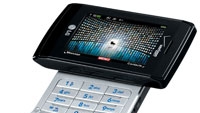ATSC mobile TV is ready to roll with nowhere to go

It’s demo time for U.S. broadcasters and their attempt to gain a slice of the mobile television pie. New mobile phones and in-vehicle devices were on display at CES in Las Vegas as a coalition of local broadcasters said they will roll out services this year in select markets.
Yet, how successful this service will be remains to be seen, as there aren’t any phones available that can currently receive the signals, and it could take until the end of the year before they are in consumers’ hands (or cars, laptops, etc.). More importantly, competition for consumer eyeballs on small screens is fierce, with the established leader in mobile television, Qualcomm’s MediaFLO —which already has the two major mobile carriers as clients — expanding rapidly.
The Open Mobile Video Coalition (OMVC), a group of more than 800 broadcasters pushing mobile technology, had multiple exhibits at the show and staged a press conference at which it announced that 63 stations in 22 markets — reaching about 35 percent of the 114.5 million U.S. television households — would use part of their digital spectrum in order to participate in a semi-national launch of mobile TV services. For example, in New York, three stations — WPXN, WNBC and WNET — will participate while in San Francisco two stations — KTVU and KXPX — will join in.
ATSC candidate standard-compliant technology is designed to provide live, local and national over-the-air digital television to consumers via next-generation portable and mobile devices at pedestrian and vehicular speeds. The final specification is not expected to be standardized until some time in the third quarter of this year, but the OMVC member stations will conduct on-air tests before then.
Of the 63 stations, 14 are NBC affiliates, nine ABC affiliates, nine CBS affiliates, five FOX affiliates, nine ION Television affiliates, four CW affiliates and four MyNetworkTV affiliates. In addition, nine PBS stations are in discussions with the OMVC to join the launch.
ATSC candidate standard tested at CES
The OMVC also conducted a live demonstration of the ATSC candidate standard at CES within the Las Vegas Convention Center. The demo involved multiple Las Vegas-based television stations broadcasting local and national TV programs to ATSC-compliant devices produced by LG Electronics and Samsung Electronics. They used prototype transmission equipment manufactured by Harris. Harris said its ATSC mobile DTV technology platform that enables broadcasters to transmit a mobile/handheld signal (once approved) would be available to stations within the next 60 days.
The complete Harris ATSC mobile DTV platform includes an Apex M2X exciter and the company’s NetVX networking platform, which features a mobile video encoder, multiplexer and encapsulator. Harris is also working with Roundbox and Triveni Digital to integrate Electronic Program Guide services for program stream and data information.
The professional video industry's #1 source for news, trends and product and tech information. Sign up below.
On the CES show floor, numerous prototype mobile DTV products were on display from Hyundai, Kenwood, LG, NBC Universal, Samsung and Visteon. Other companies had demos by invitation only in their hotel suites.
A co-developer of the ATSC mobile TV standard, LG Electronics announced handheld and mobile receiver products supporting the new candidate standard. The products include an ATSC mobile DTV MP3 player with a 3in touch-screen display, a portable DVD player with a wide 7in LCD swivel screen and integrated ATSC mobile DTV tuner; a mobile phone with a 3in touch-screen display with Electronic Service Guide functions; a mobile phone with a 2.8in dual-touch screen with QWERTY keyboard; and a USB “dongle” receiver for laptop PCs.
LG Electronics also has collaborated with several automotive electronics suppliers, including Kenwood, Visteon, Delphi and Hyundai-Kia, to show technical support for in-car ATSC mobile DTV receivers.
Tough challenges in the air
Howard L. Lance, chairman, president and chief executive officer of Harris, said mobile TV services provide local broadcasters with the ability to reach an increasingly mobile audience and new revenue models that could include the transmission of advertising and news programming to public transit vehicles and nonmoving digital signage displays.
However, broadcasters are facing serious competition in their attempt to establish viable mobile television services.
Qualcomm’s MediaFLO, with Verizon and AT&T — the two major mobile phone carriers as clients, has a considerable head start. At CES, the company announced plans to make its FLO TV service available to more than 200 million viewers across more than 100 markets in the coming year.
MediaFLO plans to work with its wireless operator partners to introduce the service in major markets including Boston, Cleveland, Houston, Miami and San Francisco. The government’s forthcoming (although possibly delayed) DTV transition will free spectrum across the country for the delivery of advanced wireless services, which will fuel the company’s growth.
MediaFLO said research shows that FLO TV viewers are spending an average of more than 20 minutes per day watching television on their phones. This is comparable to the average time U.S. cell phone users spend per day talking on their cell phones, according to CTIA’s Semi-Annual Wireless Industry Survey.
The FLO TV service is available through wireless operators in more than 65 major metropolitan areas nationwide, including Atlanta, Chicago, Dallas, Las Vegas, Los Angeles, New York, Seattle and Washington, D.C.
At CES, Audiovox announced it would make an in-car receiver for MediaFLO broadcasts. The unit, to be available in late 2009, will work with all existing in-car entertainment screens, including seat-back, dashboard and ceiling-mounted versions. There are 20 million U.S. cars with such screens.
Users will pay an undisclosed subscription fee to use the system. Currently, Verizon Wireless and AT&T cellular subscribers with compatible phones can pay $15 per month to receive 10 channels through MediaFLO.
For local broadcasters, getting an M/H test signal on the air by the summer might not be too little too late.
